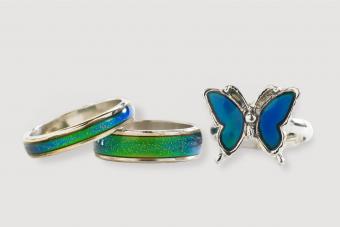
When your mood ring turns blue, it means you're feeling relaxed and ready to have fun. But what about when it turns black? Understanding mood ring color meanings can help you get the most out of this changeable piece of jewelry.
Mood rings are a fun and popular 70s-inspired jewelry item that has fascinated people for years, in large part because of what the colors are believed to represent. Mood rings respond to changes in body temperature, so many people believe that this type of jewelry can offer clues about a person's state of mind. Learn what the colors mean to help decode your moods.
Mood Ring Color Chart: What Different Shades Reveal
If you're wondering what your mood ring is saying about you, figure out its messages with this handy chart:

- Black - The person is stressed and tense. Black is the sign of someone who is overworked and harried.
- White - This person is very frustrated, possibly bored, and may even be confused.
- Gray - The individual is experiencing lower level stress and is feeling anxious and nervous. If someone is just beginning to feel uncomfortable or stressed, this is the first color sign. If the stress level heightens, the mood ring shifts to the color black.
- Brown - Nervousness is setting this person on edge. There is an overwhelming sense of restlessness and anticipation. If a person's mind is whirling with all kinds of nervous thoughts, a mood ring will turn this hue.
- Amber or gold - Someone who is feeling a range of emotions will often see her mood ring change to an amber color. These emotions can be as simple as feeling surprised or as complex as being upset or nervous.
- Yellow - The person is feeling creative, and her thoughts may be wandering.
- Pink - This is a color of uncertainty. It can indicate the beginning stages of arousal and interest.
- Orange - The wearer may be feeling a bit dare devilish and eager to try something new and exciting.
- Red - When a mood ring turns red, this means the person's heart rate is elevated. This color is a sign of high energy. This can be romantic passion or fiery anger.
- Green - This is a calm color and reveals the person isn't feeling any stress or nervousness. In fact, the person is in a good place and feels comfortable with her surroundings.
- Blue green - This is a sign of contentment and peace. The person is alert but relaxed.
- Blue - The mood is one of fun and relaxation. This person is in a good place with her emotions and is feeling happy and social.
- Dark blue - The happy mood shifts to a higher level, often signifying interest in love and romance.
- Purple - There's a sense of purpose and genuine clarity. This person knows what they want and is willing to go for it.
Do mood rings actually work to show your mood? There aren't any scientific studies that prove they do, but one study did show that a mood ring could respond to the temperature on the skin of your hand. This helps doctors diagnose nerve injuries.
How Mood Rings Change Color

The way a mood ring works is pretty fascinating. Liquid crystals are the secret to the mood ring's changing array of colors. The clear glass stone in the ring is either filled with liquid crystals or sits directly on top of a thin layer of the substance that has been adhered to a sterling setting.
Liquid crystals are extremely sensitive to heat and will twist their position in response to a rise or drop in temperature. Light comes in many different wavelengths, and each wavelength is reflected to our eyes as a different color. The position of the crystals determines which wavelengths of light are absorbed and which are reflected back to us, and this is what makes the stone appear to change color.
Your Mood May Affect Your Body Temperature
Your mood may affect your body temperature, which is what causes the ring to change colors. When you feel happy or content, your body might get slightly warmer because the capillaries move a little closer to the skin surface and release more warmth. This is what causes that well-known blush that creeps into the cheeks from time to time.
When you're nervous or anxious, extra moisture on the surface of your skin works like an evaporative cooling machine and lowers your surface temperature.
Liquid Crystals Respond to Temperature Changes
As your temperature changes, it can affect the liquid crystals in the ring. Extra warmth causes the crystals in a mood ring to alter their position, which results in shades of blue. An extremely warm reaction might even cause the color to deepen to purple, which is considered the color of passion.
If your mood ring picks up a cooler change in your body temperature, the liquid crystals rearrange themselves in ways that reflect the lighter colors in their spectrum (which produces shades ranging from amber to green).
A total absence of heat will turn the stone black, and this is how the ring will normally appear when no one is wearing it.
What Your Mood Ring Says About You
While mood ring color meanings are totally fascinating to read about and understand, they aren't exactly science. Still, wearing a mood ring just might help you become more in tune with yourself. Now that you know what the colors of a mood ring might mean, it's fun to see what your ring is saying about you.







